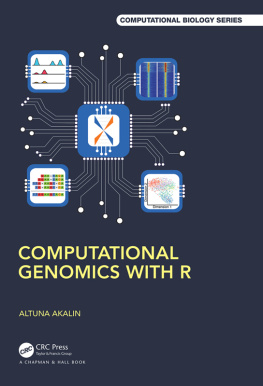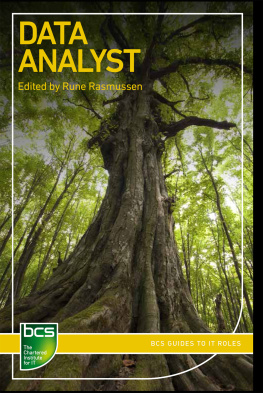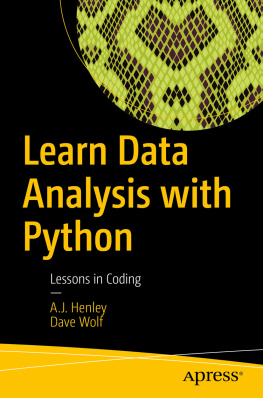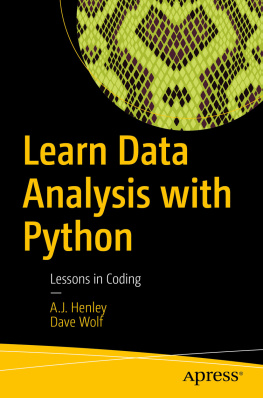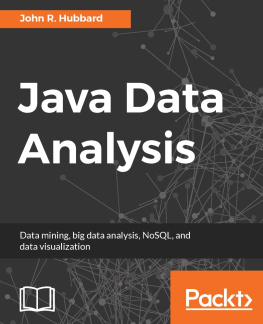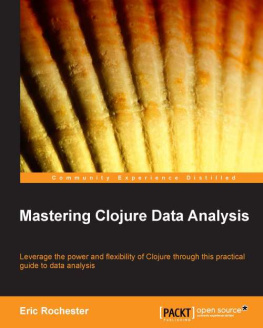In this chapter we will cover the basic steps for getting started in R. We will discuss the pros and cons of R, how to install the software and additional packages, and some suggestions on how to set up the machine to use R efficiently. We will also see how to read, manipulate, summarize, plot, and save datathe cornerstones of any analysis.
1.1 Why R?
Before praising Rs many virtues a short overview is in order. R is a software environment and programming language for statistical analysis. It is similar to the S language and a lot of code written in S can be used straight with R. Originally written by Robert Gentleman and Ross Ihaka from the University of Auckland, R is currently developed by the R Development Core Team []. At the time of writing the current version is 3.1.1.
In recent years R has become the de facto choice of many statisticians and is widely used to teach statistics courses at universities. Dozens of books have been published about R itself or on the use of statistical methodologies which are illustrated using the R environment. This book is part of a series published by Springer called Use R! which already has over 50 books published.
Now, going back to the title of this section, why R? For starters, its free. Of course cost should never be the only determinant, but then again, R is free! The concept of free extends beyond just cost. R is free to use, is free to modify, is open source, and is platform free. What this essentially means is that it is easy to work across platforms (e.g., Windows, Mac OS, and Linux), you can embed R into your own applications and you can change the code to suit your needs. R is released under the GNU public license.
Since R is a programming environment (and a programming language in its own right) users can write their own code to address particular needs without being restricted to predetermined types of analyses. Of course this comes at the cost of having to learn the syntax of the languageeven though some point and click graphical interfaces have been developed, for example R Commander [) for Affymetrix microarray analyses.
R consists of a base installation and can be extended through packages (somewhat the equivalent of programming libraries). There are thousands of packages available to tackle a wide range of problems. These packages are developed independently from the core program and can be downloaded from central repositories or, less frequently, directly from the developers web sites. And this is probably the key feature of R. Chances are that someone has already written a package that will do what you need, saving hours or days of programming it yourself. Packages can be used together allowing the output of a function in one package to be used as the input for a function in another packageessentially you have at your fingertips an overwhelming set of building blocks. Just to illustrate, this book was written entirely in R.
And this brings us to why use R for analysis of genomic data. There are hundreds of packages specifically available for this task. There are packages for importing a wide range of data formats, preprocessing data, performing quality control tests, for the actual analytical steps, downstream integration with biological databases, and so on. A large number of new algorithms and methods are published and released as an R package at the same time, thus providing quick access to the most current technologies without the slow turnover time of commercial software. Of course, theres the risk that you will be the first to find out that the new hot algorithm is not really so cool!
But its not all joy; the learning curve for R is pretty steep. The syntax, well, consider that packages are freely contributed by hundreds of developers across the world, there are no formal naming conventions and R is case sensitive! Im sure you get the picture. For example, if you want to plot a heatmap its anyones guess if the syntax is Heatmap, heatmap, HeatMap, HEATMAP or, why not, heat.Map . And to add insult to injury many packages implement similar functions, such as the following real heatmap examples: hclusterPlot, matrixPlot, heatmap, heatmap.2, heatmap_2, heatmap_plus, heatplot , and so on. So it can become quite taxing to remember the name of the package, the name of the function in the package, and the proper casing. This of course does not sit well with those who, such as myself, by noon do not seem to remember quite well what they had for breakfast. Of course there are always the help files, but they are usually unhelpful, unless you know the exact name of the function you are looking for (dont believe me? Try to search for how to invert a matrix). And web searches have to be carefully worded or they will not be of great assistance eitherhave you ever thought of how non-informative the letter R is for searching the web? As a tip, when searching online try r statistics that helps. Searches with how to using R also usually return meaningful results.
Of more practical importance is that genomic datasets have become extremely large and R was not designed for memory efficiency. There is however a strong drive in the R community to develop tools to handle these ever increasing in size datasets and new approaches/packages are continuously being developed. It is frequently intractable to load the entire dataset into memory and forget about using 32-bit Windows with its around 2GB limit per process regardless of how much memory you have available. Some workarounds for this dimensionality problem are discussed in Chap. but they will impact negatively on runtimes.
Another common comment is that R is slow, given that it is a scripted language and not a compiled one. This is not necessarily true since computationally intensive operations are usually written in C or Fortran and linked from within R. Of course we can be pedantic and say that real R is slow, but the practical result is that R is (or could be) just as fast as C or Fortran because that is whats running under the hood. Even though we are now in the criticise R section, I should highlight that since we can dynamically link to code in C or Fortran (and also other languages to various degrees), this opens the possibility of (1) using prior code or (2) developing code specifically tailored for solving a computationally intensive task and sending the results back into R to make use of its resources (e.g., plottingR excels at it).
Time to get started with R
1.2 Installing R
You can download the source code for R and compile it yourself or download binaries for quite a few platforms available from http://www.r-project.org/ . Here we will focus on the Windows release, but most of the examples we will cover can be run on any platform without changes.
To install, download the executable (around 40MB), double click to start it up, and then click on the usual next, next, next with a couple of options in between. The current version installs two versions of the R executable, a 32-bit and a 64-bit version if you are running a 64-bit version of Windows (only the 32-bit version is installed on 32-bit Windows). If you are using Mac OS, the R binary also installs 32- and 64-bit versions. Once installation is complete, to open R find the R folder in the Start Menu and click on R or R x64. This will open the R console (Fig.) and you are ready to go.


